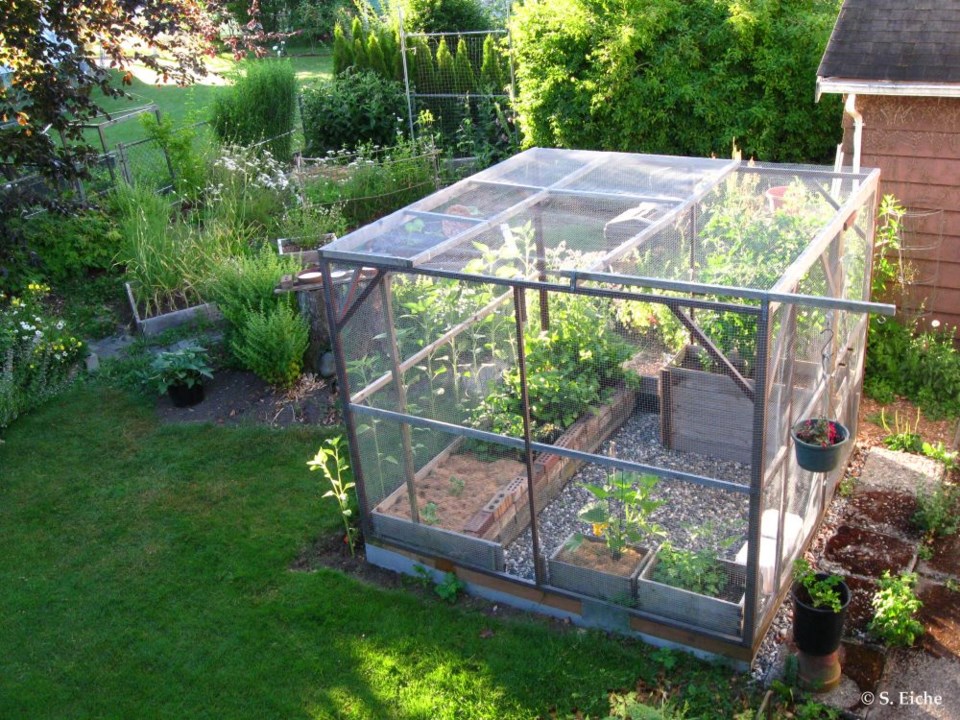I am singularly fortunate. I have a handyman with a unique combination of skills and gifts. David is an outstanding carpenter and builder who learned about construction on the job. He’s an environmentalist and will recycle and repurpose whatever he can.
A testament to his capabilities and concerns stands in my backyard – the open-air garden house (dedicated to Pomona, the ancient Roman goddess of gardens) that he designed and built using wood and mesh wire salvaged from other structures. He also respects and protects nature. Inhabitants of the soil need have no fears when he’s wielding a spade.
It turns out that my handyman is more than a sum of the above. He is also interested in foreign languages and words. Knowing that I am a logophile and a student of etymology, David recently asked me if the words clove and cloven were linked.
I had no idea, but the question sparked my curiosity. After all, words sometimes travel in unexpected ways, as I demonstrated in my 2017 Richmond News column, “What dolls, eyes, insects and puppies have in common.”
In fact, the words clove and cloven do cross paths. Cloven is formed from the past participle of the verb cleave, whose root is the Old English (AD 450-1150) cleofan, meaning to split or separate.
Around 1200, cloven was partnered with hoof to refer to the split hoofs of animals such as pigs, cattle, sheep and goats (also the devil and the ancient Roman deity Pan had cloven hoofs). Clove, referring to a component of a bulb of garlic, derives from the same source – it is a segment, something split from the whole.
But clove, the spice, came into our language from a different direction. Clove is the common name of the small evergreen tree Syzygium aromaticum, native to the Moluccas in Indonesia.
The tree’s flowers produce fruits that hold one bud each, and it’s the dried buds that we use as a spice. Their English name, clove, comes from the Latin for nail, clavus, because of the shape of the bud. Italian has kept the word nail (chiodo) in their term for clove – chiodo di garofano, literally nail of carnation. French does the same – clou di girofle, which translates as nail of gillyflower. Carnation and gillyflower are both names for flowers.
One is known as clove pink, or Dianthus caryophyllus, the latter deriving from the Greek karyophyllon, signifying dried flower bud of clove. It’s the scent of the carnation flower that underlies the association with cloves. In fact, the German word for clove, and carnation, is Nelke, from the Low German negelkin, or little nail (in Dutch the carnation is called Nagelbloem, nail flower).
And what about the word handyman? It didn’t become common until the nineteenth century, when it was also written as handy man or handy-man. The key word is, of course, hand or handy, which refers to someone who works with his hands, a manual (from the Latin manus, hand) worker. Earlier, the term for a person able to do various kinds of handy jobs was factotum.
In use by the mid-sixteenth century, it’s based on the Medieval Latin factotum, signifying do everything.
I’d say my handyman was a proper factotum, an “everything doer” because so far there hasn’t been anything that I’ve needed done that David hasn’t considered a welcome challenge. And for me, his questions about words are a big bonus.
Sabine Eiche is a local writer and art historian with a PhD from Princeton University. She is passionately involved in preserving the environment and protecting nature. Her columns deal with a broad range of topics and often include the history (etymology) of words in order to shed extra light on the subject.
Got an opinion on this story or any others in Richmond? Send us a letter or email your thoughts or story tips to [email protected]. To stay updated on Richmond news, sign up for our daily headline newsletter. Words missing in article? Your adblocker might be preventing hyperlinked text from appearing.




